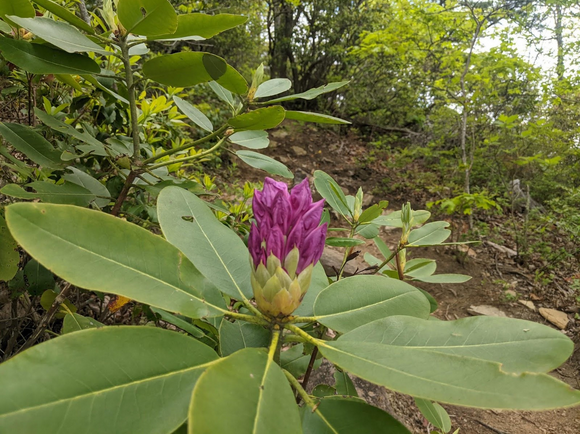
Rhododendron, a large shrub found in the forest understory, is now blooming in the Appalachian mountains. Of the Ericaceae (heather) family, the genus rhododendron can be either evergreen or deciduous shrubs. There are about a thousand different rhododendron species native to temperate regions in North America, Europe, Australia, and Asia. Most cultivated species today trace their lineage to Asia.
As a native species, rhododendrons are a source of pride in Appalachia. Rhododendron maximum is the state flower of West Virginia; it blooms abundantly from May into July and thrives in the humid and moist conditions of the Appalachian summer.
In Appalachia, there are two other plants often confused for rhododendron—azaleas and mountain laurel.

Azaleas are the state wildflower of Georgia. The differences between azaleas and rhododendrons are subtle. “All azaleas are rhododendrons, but not all rhododendrons are azaleas,” as the American Rhododendron Society described. Azaleas do not have enough botanical differences from rhododendron to be their own species, so they are a subspecies of rhododendron.

Mountain laurel is an evergreen shrub related to rhododendron and azalea as a member of the Ericaceae family. Mountain laurel is also native to eastern North America. The shrub tolerates shade well, helping it thrive in forest understory as well as in gardens that receive less sunlight.
I first learned about rhododendrons while walking through the Royal Botanic Garden Edinburgh in Scotland. Of the more than 1,000 species of rhododendron, Edinburgh’s Botanic Garden contains 819 species, making it one of the world’s largest rhododendron collections. The United Kingdom does not have any native rhododendron species, but these shrubs have become ubiquitous throughout the country.

For instance, Rhododendron ponticum from the Iberian Peninsula was introduced to England in 1763 “to be used as a cultivated flowering plant in gardens, parks, and estates as a horticultural exhibit.” After it was planted in “western Victorian hunting Estates under woodland canopies,” R.ponticum took off. Now work is underway to control it from destroying British woodlands.
Many of the species found in the Edinburgh botanic garden come from China. In the early 20th century, plant hunters from the United Kingdom traveled to the Himalayan region to collect specimens.
As Carla Cop, a master’s student at the University of Edinburgh uncovered in her dissertation exploring the human-rhododendron relationship, these expeditions “casted the European metropoles as superior to the colonized people and landscapes.” Conversely, the countries the British explored and ultimately exploited were cast as “wild” and in need of being tamed.
Considering this history, it is ironic that R.ponticum is now considered an invasive species in the UK after the British intentionally propagated and encouraged its success. Who gets to decide what belongs where and what is native or invasive is intimately connected to history, power structures, and politics, complicating the place of R.ponticum in the UK.
Politics aside, today rhododendrons are just as much part of the UK landscape as they are in China and Appalachia. The American Rhododendron Society (ARS), with members around the world, shows the global reach and appeal of rhododendron. With a mission to connect individuals interested in gardening, ARS chapters from Scotland to North Carolina go on garden tours, organize plant sales, and attend regional and national meetings.
Annie Chester is a writer and co-founder of expatalachians. She writes about the environment and culture in Appalachia and abroad.
Subscribe to The Patch, our newsletter, to stay up-to-date with new expatalachians articles and news from around Appalachia.


